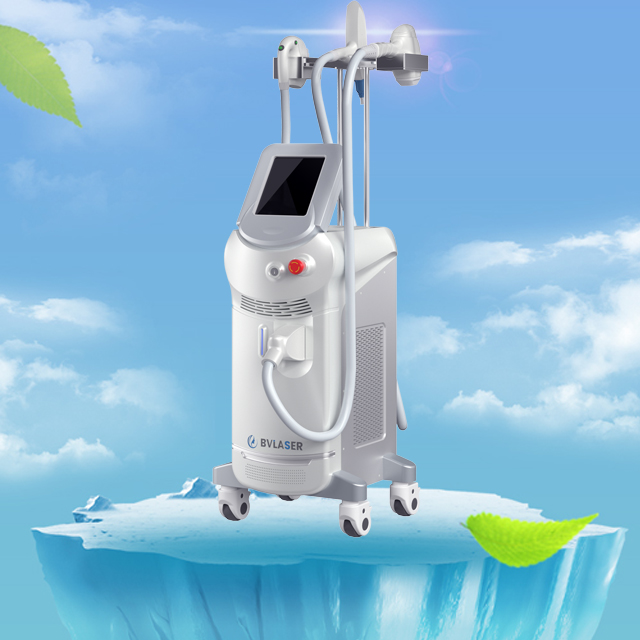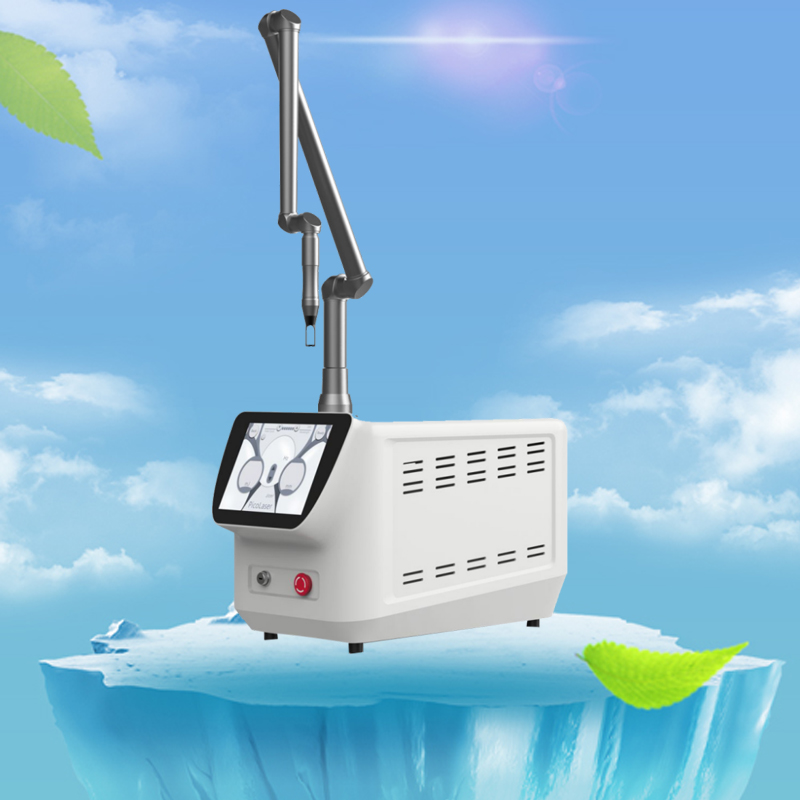Skin Tightening with Fractional CO2 Laser
Author:baishilf Time:2024-12-17 15:07:24
CO2 fractional laser machine is globally recognized as the gold standard in skin resurfacing and rejuvenation. This state-of-the-art laser treatment effectively resurfaces the skin through a series of micro-DOT wounds, ideal for targeting concerns like wrinkles, stretch marks, acne and surgical scars, and achieving firmer, smoother skin. CO2 laser skin tightening is also suitable for younger patients who are looking for more significant skin rejuvenation, dark circle treatment and eye bags treatment in fewer visits. Laser skin tightening with a CO2 fractional laser works by affecting both the epidermis and dermis layers of the skin, rather than just one. Fractional lasers affect both at the same time by utilizing tiny dots of high-intensity lasers.

How CO2 laser Works
A CO2 laser is composed of a mixture of carbon dioxide, helium, nitrogen, and hydrogen. Using very short, pulsed light energy. CO2 laser resurfacing precisely removes thin layers of skin with very little affect to surrounding tissue. The lasers work by vaporizing the outer layer of the skin by focusing in on water molecules, a procedure that reduces deep scars, wrinkles, and other imperfections.
Ideal Candidates for Skin Tightening
Over time, our bodies produce less collagen, a protein which gives the skin it’s fullness, and elastin, which gives the skin the ability to return to it’s normal position after being stretched. Due to the decrease in collagen and elastin, the skin will appear looser and begin to sag. This is what leads to loose skin and wrinkles. People with fine lines and sun damaged skin are more likely to have great improvement with fractional CO2 laser. Fairer skin is more appropriate than darker skin for this particular type of laser.

What Skin Tightening Treats
Fractional CO2 laser resurfacing is a proven treatment method for tightening loose skin. The heat introduced from the laser stimulates the skin and encourages the production of additional collagen. The result is skin that appears much closer to its younger state. CO2 lasers are capable of treating the following:
*Treating fine lines on your upper lip, cheeks or forehead.
*Rejuvenating and tightening the skin on lower and upper eyelids.
*Improving eye wrinkles (crow’s feet).
*Softening deep frown lines.
*Removing sun freckles and age spots.
*Reducing hyperpigmentation.
Recovery From Skin Tightening
Undergoing CO2 laser treatment requires a downtime of about five to seven days. This isn’t due to pain, but rather, the fact that you’ll be required to wear AquaphorTe on your face to help with healing. After this time, you can expect your recovery to improve signifcantly. After the treatment, you’ll notice a very signifcant reduction in age spots, fine lines, wrinkles, and scarring. Your skin will also be tighter and will continue to improve over the next six to nine months
after the procedure when you follow a proper skin care regimen and minimize your sun exposure.
The downsides of CO2 laser treatment
There are a few downsides to CO2 laser resurfacing when you compare them to other treatment modalities. When patients seek facial rejuvenation they may also consider micro-needling, facials, or chemical peels. All of these have less downtime than the CO2 laser and may make sense if you have an event coming up in the next few days, but they also have less of a lasting effect and could be considered more of a spa treatment than a medical procedure.
Some of the common downsides after CO2 laser treatment may include:
*Skin swelling, oozing, and discomfort.
*Cold sores, if you have a history of them.
*Inability to be in direct sunlight for a few weeks.
Even on lighter settings of CO2 laser resurfacing you will have some degree of redness. This can be adjusted based on the length of recovery the patient has available as well as the desired effects of the treatment itself – if you want greater benefits you will need a more aggressive treatment resulting in a longer downtime. For most patients, the redness/tightness/warmth lasts from 1-3 days and gives way to your face starting to peel. During this time, moisturizing is critically important, just as if you had really chapped lips: when they’re dry and cracked they hurt! Thicker moisturizing cream is used on the first few days and then you transition to a more elegant cream that provides not-so-sticky hydration to your skin.
Hyperpigmentation, or a darkening of the skin, is the greatest risk associated with CO2 laser resurfacing procedures. Ironically, a darkening of the skin is the opposite of what patients are typically after when they seek CO2 laser treatment, but this can be easily avoided. To minimize your risk of hyperpigmentation you should stay out of the sun and wear broad-spectrum sunscreen for several weeks before and after CO2 laser treatment. If hyperpigmentation does occur, however, bleaching creams can be applied to areas of the skin which were exposed to minimize the damage.
Reactivation of cold sores around the mouth is another risk associated with CO2 laser treatment. Patients with a history of herpes or cold sores may be at risk for a flare-up as a result of CO2 laser resurfacing. However, even in patients with a history of cold sores, this risk is minimal so long as they take antiviral medication before the procedure, which doctor will have prescribed in advance. To avoid problems, check your doctor’s credentials and training to ensure they’re board-certified and have proper experience to prevent the above problems from happening.
What recovery time can you expect for CO2 laser treatment?
The answer to these questions could depend on what you are personally trying to achieve. If you want to obtain the maximum benefits from CO2 laser resurfacing then we would administer the CO2 laser on a deeper or more aggressive setting, which is what people typically associate with this treatment. If the maximum benefit is what you’re after then you can expect up to six weeks of redness. The good news is, for most patients, the brunt of CO2 laser resurfacing recovery only lasts for one to two weeks.
At just two weeks, fractionated CO2 laser recovery is significantly shorter than the recovery from traditional and older ablative resurfacing procedures, which is probably what someone is talking about if you’ve heard any horror stories about recovery. Since the laser is broken into many smaller columns, CO2 laser treatment recovery time is not only shorter than traditional ablative resurfacing procedures but is also much less painful. Let’s talk about what those first two weeks of recovery look like.
The first week after your procedure you will likely experience peeling, scaling, and oozing of the skin. That might sound a little strange, but it is a perfectly normal reaction to a CO2 laser resurfacing procedure. The first couple of days after your procedure can warm and cause mild discomfort. Your face will feel tight and hot in the first few days of recovery, similar to a really bad sunburn. But just like a sunburn, this discomfort can be managed with over-the-counter pain relievers like ibuprofen and Tylenol as well as frequent moisturizing.
After that initial one to two weeks of CO2 laser resurfacing recovery, you will have new skin that may continue to look pink or red. It is critical in this stage of your recovery that you stay out of the sunlight and keep applying broad-spectrum sunscreen daily. In fact, you should keep applying that sunscreen for three months after your procedure. Think of it like a maintenance period. If you do end up exposing yourself to too much sunlight then, again, that redness could turn into hyperpigmentation.
After that sixth week of your CO2 laser recovery, all of the redness should be gone and you can expect to see improved wrinkle reduction. On top of this, your skin may continue to improve over the course of the next three to six months.
What to know before receiving CO2 laser treatment
If you expect to have the results of a facelift but only want to go through a laser procedure, you will probably be unhappy and this isn’t the correct procedure for you. Others who only want a really small recovery and very light settings may not get the benefit they were hoping for and it may not be worth the price or time. The happiest patients are those that want to maintain their current skin appearance or improve their skin quality over time with a plan for continued maintenance in the future.
The people that are best suited for CO2 laser resurfacing are typically those with lighter skin types. The amount of pigmentation in the skin determines its coloring and this pigment is also sensitive to heat. As the laser generates a controlled thermal injury to the water, some heat is dispersed. Initially, this heat is perceived as discomfort by the patient, but at the cellular level the skin will react and can ramp up the production of pigment from the excess heat which can lead to uneven results. Thus, individuals with darker skin are at greater risk of hyperpigmentation during their CO2 laser recovery and require lighter settings or may not be a candidate for this type of laser therapy at all.






















